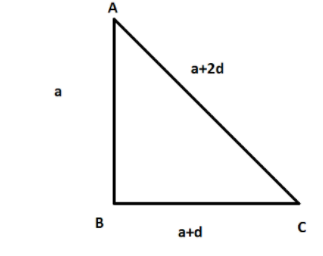
The sides of a right triangle are \[a,a + d\;\] and \[a + 2d\], with a and d both positive. The ratio of a to d is:
Answer
574.8k+ views
Hint: We are given 3 sides of a right angled triangle. We start by taking the right angle at the intersection of the smallest and the 2nd smallest line, as the hypotenuse is the largest line in the right angled triangle. Then we use Pythagoras theorem and simplifying it will give us the result.
Complete step-by-step answer:
We are given: Sides of right angled triangle is \[a;a + d;a + 2d\left[ {a,d > 0} \right]\]
We have to find: \[a:d\].
Now we, Let \[AB = a;BC = a + d;CA = a + 2d\]

\[\vartriangle ABC\;\] is right angled at B
In \[\vartriangle ABC\;\]
By Pythagoras theorem, we have,
\[A{B^2} + B{C^2} = A{C^2}\]
On substituting values we get,
\[ \Rightarrow {a^2} + {\left( {a + d} \right)^2} = {\left( {a + 2d} \right)^2}\]
On rearranging we get,
\[ \Rightarrow {a^2} = {\left( {a + 2d} \right)^2} - {\left( {a + d} \right)^2}\]
Using, \[\left[ {{a^2} - {b^2} = \left( {a + b} \right)\left( {a - b} \right)} \right]\] , we get
\[ \Rightarrow {a^2} = \left( {a + 2d + a + d} \right)\left( {a + 2d - a - d} \right)\]
On simplification we get,
\[ \Rightarrow {a^2} = \left( {2a + 3d} \right)\left( d \right)\]
On multiplication we get,
\[ \Rightarrow {a^2} = 2ad + 3{d^2}\]
On rearranging we get,
\[ \Rightarrow {a^2} - 2ad = 3{d^2}\]
Adding \[{d^2}\] to both the sides
\[ \Rightarrow {a^2} - 2ad + {d^2} = 3{d^2} + {d^2}\]
Using, \[\left[ {{{\left( {a - b} \right)}^2} = {a^2} - 2ab + {b^2}} \right]\], we get
\[ \Rightarrow {(a - d)^2} = 4{d^2}\]
Taking square root from both sides,
\[ \Rightarrow (a - d) = \pm 2d\]
So, we get,
\[ \Rightarrow a - d = 2d\] or \[ \Rightarrow a - d = - 2d\]
\[ \Rightarrow a = 3d\] or \[ \Rightarrow a = - d\]
\[a = - d\] is not possible as a and d both are positive.
Thus we get,
\[a = 3d\]
\[ \Rightarrow \dfrac{a}{d} = \dfrac{3}{1}\]
\[ \Rightarrow a:d = 3:1\]
Note: Pythagoras theorem states that “In a right-angled triangle, the square of the hypotenuse side is equal to the sum of squares of the other two sides“. The sides of this triangle have been named as Perpendicular, Base and Hypotenuse. Here, the hypotenuse is the longest side, as it is opposite to the angle \[90^\circ .\]The sides of a right triangle (say a, b and c) which have positive integer values, when squared, are put into an equation, also called a Pythagorean triplet.
Complete step-by-step answer:
We are given: Sides of right angled triangle is \[a;a + d;a + 2d\left[ {a,d > 0} \right]\]
We have to find: \[a:d\].
Now we, Let \[AB = a;BC = a + d;CA = a + 2d\]

\[\vartriangle ABC\;\] is right angled at B
In \[\vartriangle ABC\;\]
By Pythagoras theorem, we have,
\[A{B^2} + B{C^2} = A{C^2}\]
On substituting values we get,
\[ \Rightarrow {a^2} + {\left( {a + d} \right)^2} = {\left( {a + 2d} \right)^2}\]
On rearranging we get,
\[ \Rightarrow {a^2} = {\left( {a + 2d} \right)^2} - {\left( {a + d} \right)^2}\]
Using, \[\left[ {{a^2} - {b^2} = \left( {a + b} \right)\left( {a - b} \right)} \right]\] , we get
\[ \Rightarrow {a^2} = \left( {a + 2d + a + d} \right)\left( {a + 2d - a - d} \right)\]
On simplification we get,
\[ \Rightarrow {a^2} = \left( {2a + 3d} \right)\left( d \right)\]
On multiplication we get,
\[ \Rightarrow {a^2} = 2ad + 3{d^2}\]
On rearranging we get,
\[ \Rightarrow {a^2} - 2ad = 3{d^2}\]
Adding \[{d^2}\] to both the sides
\[ \Rightarrow {a^2} - 2ad + {d^2} = 3{d^2} + {d^2}\]
Using, \[\left[ {{{\left( {a - b} \right)}^2} = {a^2} - 2ab + {b^2}} \right]\], we get
\[ \Rightarrow {(a - d)^2} = 4{d^2}\]
Taking square root from both sides,
\[ \Rightarrow (a - d) = \pm 2d\]
So, we get,
\[ \Rightarrow a - d = 2d\] or \[ \Rightarrow a - d = - 2d\]
\[ \Rightarrow a = 3d\] or \[ \Rightarrow a = - d\]
\[a = - d\] is not possible as a and d both are positive.
Thus we get,
\[a = 3d\]
\[ \Rightarrow \dfrac{a}{d} = \dfrac{3}{1}\]
\[ \Rightarrow a:d = 3:1\]
Note: Pythagoras theorem states that “In a right-angled triangle, the square of the hypotenuse side is equal to the sum of squares of the other two sides“. The sides of this triangle have been named as Perpendicular, Base and Hypotenuse. Here, the hypotenuse is the longest side, as it is opposite to the angle \[90^\circ .\]The sides of a right triangle (say a, b and c) which have positive integer values, when squared, are put into an equation, also called a Pythagorean triplet.
Recently Updated Pages
Master Class 10 General Knowledge: Engaging Questions & Answers for Success

Master Class 10 Science: Engaging Questions & Answers for Success

Master Class 10 Social Science: Engaging Questions & Answers for Success

Master Class 10 Maths: Engaging Questions & Answers for Success

Master Class 10 English: Engaging Questions & Answers for Success

Master Class 10 Computer Science: Engaging Questions & Answers for Success

Trending doubts
Which of the following does not have a fundamental class 10 physics CBSE

State and prove the Pythagoras theorem-class-10-maths-CBSE

State BPT theorem and prove it class 10 maths CBSE

A triangle ABC is drawn to circumscribe a circle of class 10 maths CBSE

What is Contraception List its four different methods class 10 biology CBSE

Difference between mass and weight class 10 physics CBSE




